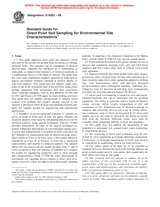Potřebujeme váš souhlas k využití jednotlivých dat, aby se vám mimo jiné mohly ukazovat informace týkající se vašich zájmů. Souhlas udělíte kliknutím na tlačítko „OK“.
ASTM D6282-98
Standard Guide for Direct Push Soil Sampling for Environmental Site Characterizations
Automaticky přeložený název:
Standardní Průvodce pro Direct Push půdní odběru vzorků pro životní prostředí Site charakterizace
NORMA vydána dne 10.7.1998
Informace o normě:
Označení normy: ASTM D6282-98
Poznámka: NEPLATNÁ
Datum vydání normy: 10.7.1998
Kód zboží: NS-34513
Počet stran: 19
Přibližná hmotnost: 57 g (0.13 liber)
Země: Americká technická norma
Kategorie: Technické normy ASTM
Anotace textu normy ASTM D6282-98 :
Keywords:
decontamination, direct push, ground water, sealing, soil sampling, ICS Number Code 13.080.99 (Other standards related to soil quality)
Doplňující informace
| 1. Scope | ||||||||||||||||||||||||||
|
1.1 This guide addresses direct push soil samplers, which also may be driven into the ground from the surface or through prebored holes. The samplers can be continuous or discrete interval units. Samplers are advanced by a combination of static push, or impacts from hammers, or vibratory methods, or a combination thereof, to the depth of interest. The guide does not cover open chambered samplers operated by hand such as augers, agricultural samplers operated at shallow depths, or side wall samplers. This guide does not address single sampling events in the immediate base of the drill hole using rotary drilling equipment with incremental drill hole excavation. Other sampling standards, such as Test Methods D 1586 and D 1587 and Practice D 3550 apply to rotary drilling activities. This guide does not address advancement of sampler barrel systems with methods that employ cuttings removal as the sampler is advanced. Other drilling and sampling methods may apply for samples needed for engineering and construction applications. 1.2 Guidance on preservation and transport of samples, as given in Guide D 4220, may or may not apply. Samples for chemical analysis often must be subsampled and reserved for chemical analysis using special techniques. Practice D 3694 provides information on some of the special techniques required. Additional information on environmental sample preservation and transportation is available in other references (1,2). Samples for classification may be preserved using procedures similar to Class A. In most cases, a direct push sample is considered as Class B in Practice D 4220 but is protected, representative, and suitable for chemical analysis. The samples taken with this practice do not usually produce Class C and D (with exception of thin wall samples of standard size) samples for testing for engineering properties, such as shear strength and compressibility. Guide D 4700 has some information on mechanical soil sampling devices similar to direct push techniques, however, it does not address most direct push sampling methods. If sampling is for chemical evaluation in the Vadose Zone, consult Guide D 4700 for any special considerations. 1.3 Field methods described in this guide, include the use of discreet and continuous sampling tools, split and solid barrel samplers and thin walled tubes with or without fixed piston style apparatus. 1.4 Insertion methods described include static push, impact, percussion, other vibratory/sonic driving, and combinations of these methods using direct push equipment adapted to drilling rigs, cone penetrometer units, and specially designed percussion/direct push combination machines. Hammers providing the force for insertion include drop style, hydraulically activated, air activated and mechanical lift devices. 1.5 Direct push soil sampling is limited to soils and unconsolidated materials that can be penetrated with the available equipment. The ability to penetrate strata is based on hammer energy, carrying vehicle weight, compactness of soil, and consistency of soil. Penetration may be limited or damage to samplers and conveying devices can occur in certain subsurface conditions, some of which are discussed in 5.5. Successful sample recovery also may be limited by the ability to retrieve tools from the borehole. Sufficient retract force must be available when attempting difficult or deep investigations. 1.6 This guide does not address the installation of any temporary or permanent soil, ground water, vapor monitoring, or remediation devices. 1.7 The practicing of direct push techniques may be controlled by local regulations governing subsurface penetration. Certification, or licensing requirements, or both, may need to be considered in establishing criteria for field activities. 1.8 The values stated in SI units are to be regarded as standard; however, dimensions used in the drilling industry are given in inch-pound units by convention. Inch-pound units are used where necessary in this guide. 1.9 This standard does not purport to address all of the safety concerns, if any, associated with its use. It is the responsibility of the user of this standard to establish appropriate safety and health practices and determine the applicability of regulatory limitations prior to use. 1.10 This guide offers an organized collection of information or a series of options and does not recommend a specific course of action. This document cannot replace education or experience and should be used in conjunction with professional judgment. Not all aspects of this guide may be applicable in all circumstances. This ASTM standard is not intended to represent or replace the standard of care by which the adequacy of a given professional service must be judged, nor should this document be applied without consideration of a project's many unique aspects. The word "Standard" in the title of this document means only that the document has been approved through the ASTM consensus process. |
||||||||||||||||||||||||||
| 2. Referenced Documents | ||||||||||||||||||||||||||
|
Odebírejte informace o nově vydaných normách ZDARMA:
Chcete pravidelně odebírat informace o nově vycházejících normách z celého světa a to zcela zdarma?
Přihlašte se k odběru. Vše je velice jednoduché a absolutně ZDARMA.
Na výběr máte vydavatele z celého světa.




 Cookies
Cookies
